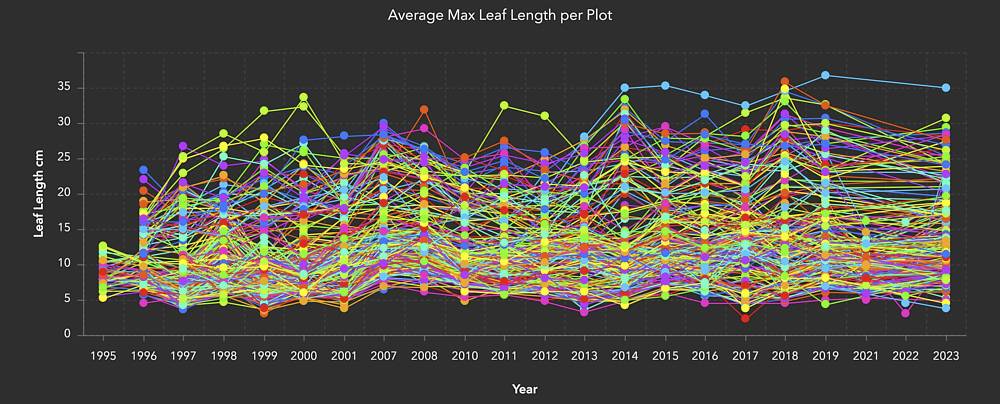Plant Height
Measuring Plants
We have been conducting studies to better understand what factors influence plant growth. One simple measurement is the inflorescence length of the sedge Carex aquatilis. The inflorescence is the stalk that holds the flowers, you could instead simply say how tall the plant is or plant height.
To the right is an image of a Carex aquatilis showing how we measure plant height.
Measurements are taken in undisturbed control plots and in plots that are experimentally warmed at Utqiaġvik and Atqasuk. Both Utqiaġvik and Atqasuk are Arctic Tundra but Atqasuk is a little further south and a little warmer, especially during the summer because Utqiaġvik is coastal and has cool winds coming from the ocean.
Tundra plant generally grow taller when it is warmer. Yet other factors such as moisture, nutrient availability, competition and herbivory may also be important.
One way to express how warm as summer has been is to calculate Thawing Degree Days (TDD). To calculate TDD, you simply add the average temperature for each day. The later in the summer, the more TDD accumulate. Likewise warmer summers have greater TDD.
Below are two different graphs showing the length of the inflorescence of Carex measured at different locations in different years.
When we graph the height of Carex against TDD, then you see a strong relationship between plant height and TDD. This provides strong evidence that the plant height is responding to temperature and growing less in cold environments and more in warm environments. The relationship also suggests a continuum that transcends locations (from colder Utqiaġvik to warmer Atqasuk), experimental warming (control plots and warmed plots) and years (cooler and warmer years).



Which of the graph does you believe do the best job of showing variability between locations (above or below)?
Which graph do you believe does the best job of showing the relationship between plant height and temperature?

Learn More
Michael Lothschutz - Response of the arctic wet meadow sedge, Carex aquatilis, to changing temperature
Chase Baldwin - The Response of the Sedge Genus Carex to Climate Change in the Arctic
Kelsey Mannard - Reproductive changes in the sedge Carex aquatilis in northern Alaska in response to experimental and climatic warming
Rob Slider - Reproductive Responses of Arctic Plants to Temperature Variation
Kelseyann Kremers - Long-Term Response of Luzula arctica and Luzula confusa to Warming in the Alaskan Tundra
Katlyn Betway - The Effects of Climate Change on Eriophorum triste; An Arctic Graminoid Species
Ellen Audia - Arctic Plant Response to Abiotic Factors in Northern Alaska
Related Papers
Arft, A.M., M.D. Walker, J. Gurevitch, J.M. Alatalo, M.S. Bret-Harte, M. Dale, M. Diemer, F. Gugerli, G.H.R. Henry, M.H. Jones, R.D. Hollister, I.S. Jónsdóttir, K. Laine, E. Lévesque, G.M. Marion, U. Molau, P. Mølgaard, U. Nordenhäll, V. Raszhivin, C.H. Robinson, G. Starr, A. Stenström, M. Stenström, Ø. Totland, P.L. Turner, L.J. Walker, P.J. Webber, J.M. Welker, and P.A. Wookey. 1999. Responses of tundra plants to experimental warming: Meta-analysis of the international tundra experiment. Ecological Monographs 69:491–511. 10.1890/0012-9615(1999)069[0491:ROTPTE]2.0.CO;2.
Barrett, R.T., and R.D. Hollister. 2016. Arctic plants are capable of sustained responses to long-term warming. Polar Research 35:25405. 10.3402/polar.v35.25405.
Barrett, R.T.S., R.D. Hollister, S.F. Oberbauer, and C.E. Tweedie. 2015. Arctic plant responses to changing abiotic factors in northern Alaska. American Journal of Botany 102:2020–2031. 10.3732/ajb.1400535.
Hollister, R.D., P.J. Webber, and C. Bay. 2005. Plant response to temperature in northern Alaska: Implications for predicting vegetation change. Ecology 86:1562–1570. 10.1890/04-0520.
Kremers, K.S., R.D. Hollister, and S.F. Oberbauer. 2015. Diminished response of arctic plants to warming over time. Plos One 10:e0116586. 10.1371/journal.pone.0116586.








